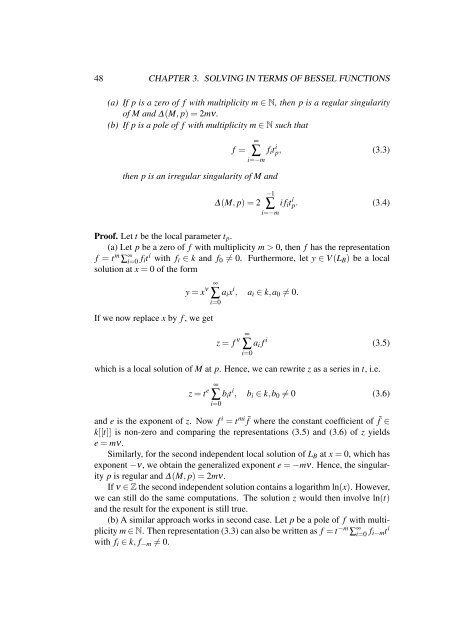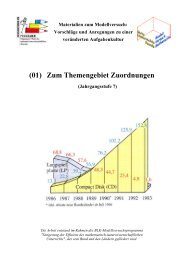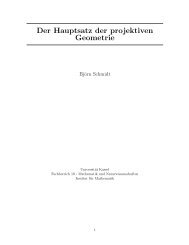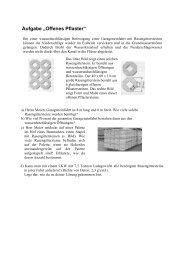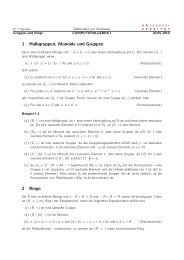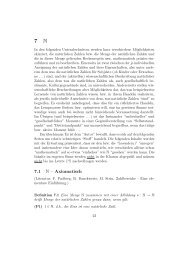Solving Differential Equations in Terms of Bessel Functions
Solving Differential Equations in Terms of Bessel Functions
Solving Differential Equations in Terms of Bessel Functions
Create successful ePaper yourself
Turn your PDF publications into a flip-book with our unique Google optimized e-Paper software.
48 CHAPTER 3. SOLVING IN TERMS OF BESSEL FUNCTIONS<br />
(a) If p is a zero <strong>of</strong> f with multiplicity m ∈ N, then p is a regular s<strong>in</strong>gularity<br />
<strong>of</strong> M and ∆(M, p) = 2mν.<br />
(b) If p is a pole <strong>of</strong> f with multiplicity m ∈ N such that<br />
f =<br />
then p is an irregular s<strong>in</strong>gularity <strong>of</strong> M and<br />
∆(M, p) = 2<br />
∞<br />
∑ fit<br />
i=−m<br />
i p, (3.3)<br />
−1<br />
∑<br />
i=−m<br />
i fit i p. (3.4)<br />
Pro<strong>of</strong>. Let t be the local parameter tp.<br />
(a) Let p be a zero <strong>of</strong> f with multiplicity m > 0, then f has the representation<br />
f = t m ∑ ∞ i=0 fit i with fi ∈ k and f0 = 0. Furthermore, let y ∈ V (LB) be a local<br />
solution at x = 0 <strong>of</strong> the form<br />
∞<br />
ν<br />
y = x ∑<br />
i=0<br />
If we now replace x by f , we get<br />
aix i , ai ∈ k,a0 = 0.<br />
∞<br />
ν<br />
z = f ∑ ai f<br />
i=0<br />
i<br />
which is a local solution <strong>of</strong> M at p. Hence, we can rewrite z as a series <strong>in</strong> t, i.e.<br />
∞<br />
e<br />
z = t ∑<br />
i=0<br />
(3.5)<br />
bit i , bi ∈ k,b0 = 0 (3.6)<br />
and e is the exponent <strong>of</strong> z. Now f i = tmi ¯f where the constant coefficient <strong>of</strong> ¯f ∈<br />
k[[t]] is non-zero and compar<strong>in</strong>g the representations (3.5) and (3.6) <strong>of</strong> z yields<br />
e = mν.<br />
Similarly, for the second <strong>in</strong>dependent local solution <strong>of</strong> LB at x = 0, which has<br />
exponent −ν, we obta<strong>in</strong> the generalized exponent e = −mν. Hence, the s<strong>in</strong>gularity<br />
p is regular and ∆(M, p) = 2mν.<br />
If ν ∈ Z the second <strong>in</strong>dependent solution conta<strong>in</strong>s a logarithm ln(x). However,<br />
we can still do the same computations. The solution z would then <strong>in</strong>volve ln(t)<br />
and the result for the exponent is still true.<br />
(b) A similar approach works <strong>in</strong> second case. Let p be a pole <strong>of</strong> f with multiplicity<br />
m ∈ N. Then representation (3.3) can also be written as f = t−m ∑ ∞ i=0 fi−mti with fi ∈ k, f−m = 0.


